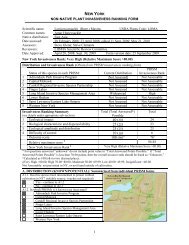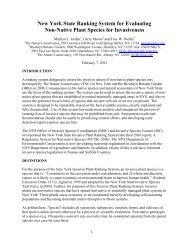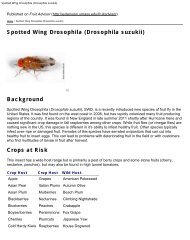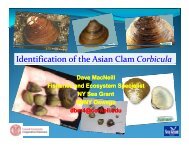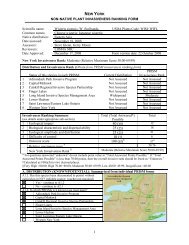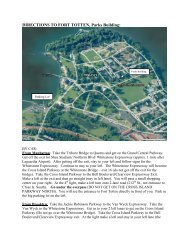Emerald Ash Borer - New York Invasive Species Information
Emerald Ash Borer - New York Invasive Species Information
Emerald Ash Borer - New York Invasive Species Information
Create successful ePaper yourself
Turn your PDF publications into a flip-book with our unique Google optimized e-Paper software.
David Cappaert, Michigan State University, bugwood.org<br />
<strong>Emerald</strong> <strong>Ash</strong> <strong>Borer</strong>:<br />
An Introduction<br />
Preparing for the <strong>Emerald</strong> <strong>Ash</strong> <strong>Borer</strong><br />
http://nyis.info/eab
Pennsylvania Department of Conservation and Natural Resources - Forestry Archive, Bugwood.org<br />
EAB Basics<br />
The <strong>Emerald</strong> <strong>Ash</strong> <strong>Borer</strong> is a<br />
small green beetle whose<br />
larva feed on the living<br />
tissue of ash trees between<br />
the bark and the wood.<br />
No ash tree is safe from EAB.<br />
Unless precautions are<br />
taken, ALL ASH TREES WILL<br />
BE KILLED BY THE EMERALD<br />
ASH BORER.<br />
James W. Smith, USDA APHIS PPQ, Bugwood.org<br />
Preparing for the <strong>Emerald</strong> <strong>Ash</strong> <strong>Borer</strong><br />
http://nyis.info/eab
What does this mean<br />
• 1 in 14 trees in <strong>New</strong> <strong>York</strong> is an ash tree<br />
• Thousands of ash line our trees, shade our parks<br />
and fill our public spaces.<br />
• Thousands more dot our home landscapes<br />
• Millions can be found in our woodlots and along our<br />
rivers and streams.<br />
EAB puts all<br />
of these trees<br />
in danger.<br />
Preparing for the <strong>Emerald</strong> <strong>Ash</strong> <strong>Borer</strong><br />
http://nyis.info/eab
Preparing for the <strong>Emerald</strong> <strong>Ash</strong> <strong>Borer</strong><br />
http://nyis.info/eab
Pennsylvania Department of Conservation and Natural<br />
Resources - Forestry Archive, Bugwood.org<br />
Result<br />
When <strong>Emerald</strong> <strong>Ash</strong> <strong>Borer</strong> infest an ash, there is<br />
only one result unless that ash is treated.<br />
Preparing for the <strong>Emerald</strong> <strong>Ash</strong> <strong>Borer</strong><br />
http://nyis.info/eab
The EAB in North America<br />
• First recognized as a problem near Detroit,<br />
MI in 2002<br />
• Established in mid 1990’s<br />
• Hitchhiked in wood packing material<br />
• Has spread to 15 states<br />
and 2 Provinces<br />
• Movement by:<br />
– Firewood<br />
– Nursery stock<br />
– And flight<br />
Preparing for the <strong>Emerald</strong> <strong>Ash</strong> <strong>Borer</strong><br />
http://nyis.info/eab<br />
Howard Russell,<br />
Michigan State University,<br />
Bugwood.org
December 2006<br />
Preparing for the <strong>Emerald</strong> <strong>Ash</strong> <strong>Borer</strong><br />
http://nyis.info/eab
October 2009<br />
Preparing for the <strong>Emerald</strong> <strong>Ash</strong> <strong>Borer</strong><br />
http://nyis.info/eab
August 2012<br />
Preparing for the <strong>Emerald</strong> <strong>Ash</strong> <strong>Borer</strong><br />
http://nyis.info/eab
<strong>Emerald</strong> <strong>Ash</strong> <strong>Borer</strong> Impact<br />
Preparing for the <strong>Emerald</strong> <strong>Ash</strong> <strong>Borer</strong><br />
http://nyis.info/eab
No untreated ash materials can be<br />
moved from these areas<br />
Preparing for the <strong>Emerald</strong> <strong>Ash</strong> <strong>Borer</strong><br />
http://nyis.info/eab
EAB Life cycle<br />
Eggs<br />
David Cappaert, Michigan State University, forestryimages.org<br />
Adults lay eggs in<br />
mid to late June<br />
Eggs laid on bark<br />
surface, cracks<br />
Hatch in 7 to 10<br />
days<br />
David Cappaert, Michigan State University, Bugwood.org<br />
Larvae<br />
David Cappaert, Michigan State University, bugwood.org<br />
Larva – four instars- 301 to 315 days- June - April<br />
“nested bells” appearance of body segments<br />
“S” shaped feeding pattern<br />
Preparing for the <strong>Emerald</strong> <strong>Ash</strong> <strong>Borer</strong><br />
http://nyis.info/eab
EAB Life cycle<br />
Pre pupa<br />
David Cappaert, Michigan State University, bugwood.org<br />
Pupa<br />
David Cappaert, Michigan State University, bugwood.org<br />
Pupa – about 28 days: May<br />
Preparing for the <strong>Emerald</strong> <strong>Ash</strong> <strong>Borer</strong><br />
http://nyis.info/eab
Daniel Herms, The Ohio State University, Bugwood.org<br />
David Cappaert, Michigan State University, bugwood.org<br />
“D” shaped emergence holes<br />
EAB Life cycle<br />
David Cappaert, Michigan State University, bugwood.org<br />
Adult – female lives 21 to 25 days:<br />
May and early June<br />
2-3 week maturation feeding on leaves<br />
Female lays 60 to 90 eggs<br />
Preparing for the <strong>Emerald</strong> <strong>Ash</strong> <strong>Borer</strong><br />
http://nyis.info/eab
What to look for:<br />
Signs of EAB<br />
• “D” shaped exit hole<br />
• “S” galleries under the<br />
bark (or larvae)<br />
David Cappaert, Michigan State University, Bugwood.org<br />
David R. McKay, USDA APHIS PPQ, Bugwood.org<br />
Preparing for the <strong>Emerald</strong> <strong>Ash</strong> <strong>Borer</strong><br />
http://nyis.info/eab
Symptoms of EAB<br />
Woodpecker foraging<br />
Preparing for the <strong>Emerald</strong> <strong>Ash</strong> <strong>Borer</strong><br />
http://nyis.info/eab
What to look for: Symptoms of EAB<br />
Bark splitting<br />
Preparing for the <strong>Emerald</strong> <strong>Ash</strong> <strong>Borer</strong><br />
http://nyis.info/eab
Signs & Symptoms<br />
Epicormic, or water sprouts<br />
Preparing for the <strong>Emerald</strong> <strong>Ash</strong> <strong>Borer</strong><br />
http://nyis.info/eab
Symptoms of EAB<br />
Canopy thinning- smaller leaves and leaflets<br />
Preparing for the <strong>Emerald</strong> <strong>Ash</strong> <strong>Borer</strong><br />
http://nyis.info/eab
Tree death generally<br />
takes 2 to 3 years.<br />
Infestations in the<br />
Midwest are lasting<br />
for up to 11–12 years.<br />
Preparing for the <strong>Emerald</strong> <strong>Ash</strong> <strong>Borer</strong><br />
http://nyis.info/eab
We want to SLow <strong>Ash</strong> Mortality- SLAM<br />
Through:<br />
–Surveying and Early Detection<br />
– Visual signs and symptoms<br />
– Purple traps and girdled trees<br />
– then Population Reduction<br />
• Remove infested trees and destroy EAB<br />
• Create clusters of girdled trees to attract<br />
female EAB<br />
– They are removed and destroyed after egg laying<br />
Preparing for the <strong>Emerald</strong> <strong>Ash</strong> <strong>Borer</strong><br />
http://nyis.info/eab
Tactics<br />
Long Term<br />
• Resistance<br />
– ID and incorporate genetically into native species<br />
• Just getting started<br />
• Biological Controls<br />
– Parasitoid wasps in culture (Asian and native).<br />
Fungus a possibility<br />
Infested Trees<br />
• Mechanical<br />
– whole tree removal or chipping to 1 inch in 2 dimensions of infested<br />
trees (or removing the bark outer ½ of wood, interior wood is still<br />
useable)<br />
• Insecticides<br />
– Systemic Insecticides are the only truly effective EAB insecticides<br />
Preparing for the <strong>Emerald</strong> <strong>Ash</strong> <strong>Borer</strong><br />
http://nyis.info/eab
Community<br />
Trees<br />
Think of this<br />
as your community.<br />
Each of these purple<br />
dots is an ash tree.<br />
• What are your<br />
options<br />
• Who will be<br />
impacted by your<br />
management<br />
decisions<br />
Preparing for the <strong>Emerald</strong> <strong>Ash</strong> <strong>Borer</strong><br />
http://nyis.info/eab
Tree Management Option 1: Remove<br />
– Street tree removal<br />
Range of $150 to $2000 + per<br />
tree<br />
• Size of tree, condition of tree,<br />
location of tree, and contractor<br />
versus staff all affect price.<br />
– Residential Trees can be even<br />
more<br />
– In forests, conduct a timber or<br />
firewood harvest<br />
Pennsylvania Department of Conservation and Natural<br />
Resources - Forestry Archive, Bugwood.org<br />
Preparing for the <strong>Emerald</strong> <strong>Ash</strong> <strong>Borer</strong><br />
http://nyis.info/eab
Tree Management Option 2: Insecticides<br />
Issue one- different types of insecticides:<br />
– Effectiveness/appropriateness of<br />
individual chemicals depends on<br />
pest pressure at each location.<br />
• Depending on your distance from an<br />
infestation, and the size of that infestation there are<br />
different recommendations. See http://www.nyis.info/eab<br />
for maps and recommendations<br />
– Generally, there is less risk to your ash tree if it is more than 10<br />
miles from an infestation zone.<br />
– Effectiveness of insecticides vary<br />
• Imidacloprid – only non-professional chemical registered<br />
• Emamectin benzoate (Tree-age) – most effective, can kill EAB in<br />
an already infested tree (up to 40% infested)<br />
• Azadirachtin (TreeAzin) – neem seed product, new, inconclusive<br />
– Insecticides have different application frequencies<br />
Preparing for the <strong>Emerald</strong> <strong>Ash</strong> <strong>Borer</strong><br />
http://nyis.info/eab
Tree Management Option 2: Insecticides<br />
• Issue2 : Condition of<br />
Tree – ineffective spread of<br />
systemic insecticides to the<br />
crown of old and structurally<br />
damaged trees<br />
Is this the tree<br />
you intend to<br />
save<br />
Preparing for the <strong>Emerald</strong> <strong>Ash</strong> <strong>Borer</strong><br />
http://nyis.info/eab
Tree Management Option 3: Do Nothing<br />
Pennsylvania Department of Conservation and Natural Resources - Forestry Archive, Bugwood.org<br />
There is the option of not<br />
removing or treating<br />
trees. In forested and<br />
unused areas this is a<br />
fine option. Removing<br />
all of the ash trees<br />
from an area will not<br />
protect other ash<br />
trees.<br />
Preparing for the <strong>Emerald</strong> <strong>Ash</strong> <strong>Borer</strong><br />
http://nyis.info/eab
Tree Management Option 3: Do Nothing<br />
For street trees, park<br />
trees, and yard trees<br />
this is not an option.<br />
Dead ash trees are a<br />
public safety issue.<br />
Dead ash trees lose<br />
their limbs which can<br />
cause damage to people<br />
and property.<br />
Preparing for the <strong>Emerald</strong> <strong>Ash</strong> <strong>Borer</strong><br />
http://nyis.info/eab<br />
Steven Katovich, USDA Forest Service, Bugwood.org
Tree Management Option 3: Do Nothing<br />
In utility right of ways and along rural roads, ash<br />
trees are a liability, but that human safety<br />
liability may be lower based on exact location.<br />
But, there are<br />
still costs<br />
associated<br />
with clearing<br />
debris from roads<br />
and wires.<br />
Rebekah D. Wallace, University of Georgia, Bugwood.org<br />
Preparing for the <strong>Emerald</strong> <strong>Ash</strong> <strong>Borer</strong><br />
http://nyis.info/eab
Woodlot <strong>Ash</strong> Trees<br />
Now is the time to think about what you have and<br />
what you want to do<br />
• What are your goals<br />
• Utilization:<br />
• lumber<br />
• firewood<br />
• Recreation:<br />
• dead ash could be<br />
a safety hazard<br />
• What do you have Are they big enough/good enough<br />
to be used<br />
Preparing for the <strong>Emerald</strong> <strong>Ash</strong> <strong>Borer</strong><br />
http://nyis.info/eab
Woodlot Management<br />
• Don’t need to remove all ash trees<br />
– Won’t slow down EAB once infestation starts<br />
growing<br />
• Don’t have hasty harvests<br />
– Could have 10+ more years of growth<br />
Leah Bauer, USDA FS NRS, Bugwood.org<br />
Preparing for the <strong>Emerald</strong> <strong>Ash</strong> <strong>Borer</strong><br />
http://nyis.info/eab
Woodlot<br />
Management<br />
• Don’t sacrifice other<br />
trees, or take trees<br />
not included in your<br />
plan, just to justify a<br />
timber sale.<br />
It may not be worth<br />
it.<br />
• Work with a Forester<br />
– take inventory<br />
– write a plan<br />
Preparing for the <strong>Emerald</strong> <strong>Ash</strong> <strong>Borer</strong><br />
http://nyis.info/eab<br />
Chili Site - John Gibbs, NYS DEC
Community Trees: How do you decide<br />
what to do<br />
• Where are your ash trees What is their<br />
condition<br />
– Which ones will be a hazard.<br />
– Locate the closest infestations<br />
• What are the costs to remove vs. treat<br />
(or a combination)<br />
• Consider the impact of each scenario on the your<br />
home, community or landscape<br />
• What are your long term goals for your property<br />
• What are your community’s long term goals<br />
Preparing for the <strong>Emerald</strong> <strong>Ash</strong> <strong>Borer</strong><br />
http://nyis.info/eab
Management Considerations- Pest<br />
Pressure<br />
Pest Pressure is a critical factor in management decisions:<br />
• The number of individual bugs attacking a tree<br />
determines:<br />
– How quickly a tree will be killed<br />
– Rate of spread (the more insects the faster it will be)<br />
• Base Your Treatment Decisions on Pest Pressure<br />
– Timing of management decisions<br />
– Pesticide effectiveness varies<br />
• Remember that Pest Detection is difficult at low<br />
Pest Pressure<br />
Preparing for the <strong>Emerald</strong> <strong>Ash</strong> <strong>Borer</strong><br />
http://nyis.info/eab
Tiers and Management<br />
• Tier I- Small Infestation<br />
– Do not apply insecticides until the leading edge of the<br />
EAB infestation is within 1 mile of your tree<br />
– Now is the time to inventory, assess, and plan<br />
• Tier II- Mid- Size Infestation<br />
– Do not apply until EAB infestation is within 5 miles<br />
– Consider implementing your plan<br />
• Tier III- Large Infestation<br />
– Do not apply until EAB infestation is within 10 miles<br />
– Consider immediate plan implementation<br />
Preparing for the <strong>Emerald</strong> <strong>Ash</strong> <strong>Borer</strong><br />
http://nyis.info/eab
No untreated ash materials can be<br />
moved from these areas<br />
Preparing for the <strong>Emerald</strong> <strong>Ash</strong> <strong>Borer</strong><br />
http://nyis.info/eab
Impact of EAB<br />
St. Paul, MN <strong>Ash</strong> Removal- Minn. Public Radio, Nov 2009<br />
Preparing for the <strong>Emerald</strong> <strong>Ash</strong> <strong>Borer</strong><br />
http://nyis.info/eab
Impact of EAB<br />
St. Paul, MN <strong>Ash</strong> Removal- Minn. Public Radio, Nov 2009<br />
Preparing for the <strong>Emerald</strong> <strong>Ash</strong> <strong>Borer</strong><br />
http://nyis.info/eab
What can you do to NOW help <strong>Ash</strong> Trees<br />
• Slow the Spread- Don’t Move Firewood<br />
• Serve on an EAB Community Preparedness Planning<br />
committee to make decisions for your community.<br />
• Help Conduct Community Tree Inventories<br />
• Monitor for EAB<br />
• Report Suspicious Sightings<br />
– Local CCE Office http://www.cce.cornell.edu/<br />
– DEC Hotline (866)640-0652<br />
– http://beetledetectives.com/<br />
• Collect <strong>Ash</strong> Tree Seed<br />
http://www.nsl.fs.fed.us/geneticconservation_ash.html<br />
• Educate Yourself and Your Friends and Neighbors<br />
Preparing for the <strong>Emerald</strong> <strong>Ash</strong> <strong>Borer</strong><br />
http://nyis.info/eab
LOCAL EAB Task Forces<br />
A place for local experts and volunteers to<br />
gather and develop local EAB response plans<br />
• EAB Task Forces can<br />
– Educate the public<br />
– Provide a forum for local resource identification<br />
and sharing<br />
– Coordinate and train volunteers<br />
• Inventory, monitor, and educate<br />
Preparing for the <strong>Emerald</strong> <strong>Ash</strong> <strong>Borer</strong><br />
http://nyis.info/eab
More Assistance<br />
• CCE <strong>New</strong> <strong>York</strong> <strong>Invasive</strong> <strong>Species</strong> <strong>Information</strong><br />
Web Site: www.nyis.info<br />
• Cornell Cooperative Extension:<br />
www.cce.cornell.edu<br />
• NYS Department of Environmental<br />
Conservation: www.dec.ny.gov<br />
• NYS Agriculture and Markets:<br />
www.agmkt.state.ny.us/PI/eab.html<br />
Preparing for the <strong>Emerald</strong> <strong>Ash</strong> <strong>Borer</strong><br />
http://nyis.info/eab
Thoughtful solutions result in a better outcome.<br />
We may not be able to stop it right now, but we<br />
can Slow The Spread<br />
Preparing for the <strong>Emerald</strong> <strong>Ash</strong> <strong>Borer</strong><br />
http://nyis.info/eab
Credits<br />
NYS EAB Web Site: http://nyis.info/eab<br />
• Presentation prepared by<br />
– Rebecca Hargrave, Horticulture and Natural Resources<br />
Extension Educator, Cornell Cooperative Extension of<br />
Chenango County, jrh45@cornell.edu, and<br />
– Mark Whitmore, Forest Entomologist with Cornell<br />
University Department of Natural Resources<br />
mcw42@cornell.edu<br />
• Funded by USDA/APHIS and<br />
Cornell University<br />
July 26, 2012<br />
Preparing for the <strong>Emerald</strong> <strong>Ash</strong> <strong>Borer</strong><br />
http://nyis.info/eab



